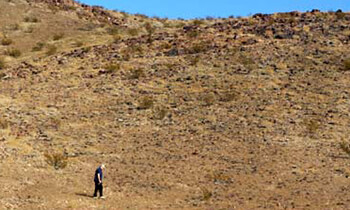Southwestern Arts and Crafts
Native Americans
by Lynn M. Bremner
Native American cultures of the Southwest portray a colorful and varied heritage through their fine arts 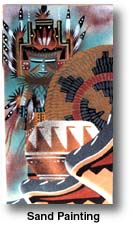 and crafts. Many of the designs and symbols prominent in Native American craftwork represent ideas that are important to their cultures. Images of crops, rain, feathers, lightning, animals and other nature symbols are prominent in Native American art.
and crafts. Many of the designs and symbols prominent in Native American craftwork represent ideas that are important to their cultures. Images of crops, rain, feathers, lightning, animals and other nature symbols are prominent in Native American art.
The purpose of this article is to introduce you to a variety of Native American arts and crafts, as well as the religious, cultural and economic influences that have shaped their development.
All craftwork has an economic purpose --to use, to buy or to trade. For centuries, Native American crafts have been used in religious ceremonies, to barter for trade or for their utility, as a functional part of every day life. Through the centuries, new ideas, changing markets, and the introduction of new tools and materials have greatly influenced the development of their craftwork.
functional part of every day life. Through the centuries, new ideas, changing markets, and the introduction of new tools and materials have greatly influenced the development of their craftwork.
Basketry and pottery are some of the oldest and most functional of Native American crafts. Silverwork, painting on paper and commercial sandpaintings are newer art forms, that have been driven by European influences and developing markets. Other items such as Kachina carvings and fetishes have been used for centuries to teach religion, represent spirits and as gifts and blessings.
Kachina Dolls
The Hopi believe that all things in the world have both a spiritual form and a material form. They do not worship the Kachinas, but consider them allies of the pueblo and are respected by the villagers. There are more than 200 different Kachina spirits ranging from butterflies, eagles and bugs, to the sun, corn and clouds.
 The word "Kachina" can mean an actual spirit being, an impersonation of a spirit by Hopi Men or a carved figure of the spirit. Hopi men are considered Kachinas when they dress to impersonate spirits during religious ceremonies. The Hopi believe that each Kachina dancer is half human and half spirit.
The word "Kachina" can mean an actual spirit being, an impersonation of a spirit by Hopi Men or a carved figure of the spirit. Hopi men are considered Kachinas when they dress to impersonate spirits during religious ceremonies. The Hopi believe that each Kachina dancer is half human and half spirit.
Traditionally, Kachina dolls were carved from whole pieces of Cottonwood root and given as gifts by Kachina dancers to women and children during the ceremonies. The carvings are given to ensure fertility, educate young children and to give a part of the spirit to a loved one.
The Hopi are best known for their Kachina carvings, but other pueblos and tribes also create the popular carvings. Over the years, the materials available, modern technology and market demand have given way to more sophisticated Kachina dolls with moving limbs and props. Leather, feathers, beads, colorful paints and other materials available to the artist are now used to create Kachina dolls.
Cottonwood root is the traditional and most prized material for carving Kachina dolls. Cottonwood limbs are used only when root is not available. Other woods have been tried, but are not very popular among the artists or collectors.
Skill, quality and style vary from artist to artist. When evaluating a Kachina doll for purchase, make sure you check for good carving shown by proper body proportions. Look for finished details, and make sure there are no cracks or flaws in the surface of the wood. If made from Cottonwood root, the doll should be light. If the wood easily dents, it may be made from balsa wood and is not a good quality doll. Heavier dolls may be carved from pine or cottonwood limbs, which are substitutes. Make sure the painting is done with straight lines and firm edges. Details and symbols should be precise and well crafted.
Accuracy is one of the most important elements and also one of the most difficult for collectors to evaluate. Villages have their own style and variations of details, which may be accurate for one pueblo but inaccurate for another. Do your research and read up on Kachina dolls to learn about such variations.
Silverwork
One of the most prominent and well-known of all Indian crafts is Silverwork. Ironically, Silverwork is among one of the newer crafts adopted by Native Americans of the Southwest. In fact, some of the techniques used such as the overlay, weren't developed until the 1930s. Few tribes worked with metal prior to 1850, when some of the first silversmithing was learned. Mexican plateros played a significant role in teaching the fine craft of silversmithing to the Indian tribes.
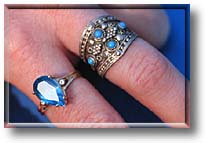 Earlier silver pieces were replicas of Spanish ornaments, including bridle decorations, earrings, wire bracelets and beads. Stamp work and chisel work were the primary decoration on the silver. Stones weren't introduced until the 1890s, when shell, beads, precious and semi-precious stones were experimented with. Turquoise was and remains the most popular.
Earlier silver pieces were replicas of Spanish ornaments, including bridle decorations, earrings, wire bracelets and beads. Stamp work and chisel work were the primary decoration on the silver. Stones weren't introduced until the 1890s, when shell, beads, precious and semi-precious stones were experimented with. Turquoise was and remains the most popular.
The use of turquoise in silver jewelry was greatly influenced by the Hubbell Trading Post, where the owner imported Persian turquoise to encourage the popular combination. Later, the discovery and mining of local turquoise spurred the continued development and demand for turquoise jewelry.
Importation of Coral from Japan in the 1930s encouraged its use in Native American jewelry. The shell of the Spiny Oyster was used before Coral became available. The red-orange material was traded from the coast of Baja, California.
Sandpainting
Sandpaintings have been part of the Navajo culture for centuries, but only during the last 50 years has the art of sandpainting been commercialized as an art form.
Called "ikaah," sandpaintings are used in Navajo Chantway ceremonies performed to help bring an ill patient back into harmony and balance. Navajo Medicine men, also called hatathli , have warned that duplicating the religious symbols used in the ceremonies will cause illness to befall the artist. For this reason, sandpainters often alter, or change the symbols used in their commercial products.
During the religious ceremonies, sandpaintings are created on the ground between sunrise and sunset of the same day. Because of this ritual, sandpaintings were not recorded by photograph or in painted replication until the 1950s. It was only after this time that the new art of sandpainting on particle board began to evolve.
The sand used in the paintings is created by the artist from grinding rock found within the local environment. A specially thinned white glue is used to prepare the particle board for the sand medium. Precision and skill are required to produce the finely crafted sandpaintings. Patience is also a necessity, since each color must be dry and set before the next can be applied.
Baskets
Basket weaving is one of the oldest and most significant crafts of Native American cultures. The importance of baskets in religious ceremonies and as a traditional component of the Native American household, has kept the tradition of basket weaving alive.
The time, materials and skill required to create baskets exceed their monetary value in the market place. The most skilled and talented weavers earn no more than a few dollars per hour for their labor. The demand for handcrafted baskets, especially among the Native American communities, continues to drive the market.
 There are many different types, styles and uses for handcrafted baskets. Burden baskets are used by the Apache during women's puberty rite ceremonies. Baskets are also used as payment for ceremonial services and during prayer offerings. The Hopi use coiled baskets as awards and gifts for competitions, while the Navajo use baskets during a curing ceremony.
There are many different types, styles and uses for handcrafted baskets. Burden baskets are used by the Apache during women's puberty rite ceremonies. Baskets are also used as payment for ceremonial services and during prayer offerings. The Hopi use coiled baskets as awards and gifts for competitions, while the Navajo use baskets during a curing ceremony.
Native Americans have handcrafted baskets for centuries and continue to use many of the traditional materials and processes in modern weaving. Some of the materials used are seasonal and only found in specific regions. It is not uncommon for weavers to travel many miles to obtain certain materials for their weaving projects. Willow, yucca, cattails, devils claw, horsehair and grasses are commonly used materials. Decorations of rawhide tassels with beads, feathers and other ornaments attached are sometimes added to the baskets for visual effect or to aid in functionality of the basket.
To evaluate a fair price and quality of a basket, you must look at the fineness of the weave, complexity of design, symmetry, type of materials used and the size of the basket. Some materials such as willow, take more time to prepare and weave, which will yield a higher priced basket.
Fetishes
Indians of the Southwest believe some objects have spirits -- they call these objects "fetishes." Almost any object can be considered a fetish, including arrowheads, unusual rocks, concretions, shells and carvings. There is a fine line between an object that is a fetish and one that is not. A true fetish is created with the belief that the object has special supernatural powers. When treated with respect, a fetish is believed to assist its owner.
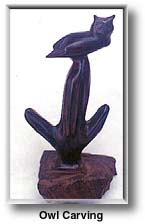 When not in use, a fetish is stored in a leather pouch, jar or wrapped in a special covering. Hunting fetishes are sometimes fed the blood of a kill, while other fetishes may be fed cornmeal or other food periodically.
When not in use, a fetish is stored in a leather pouch, jar or wrapped in a special covering. Hunting fetishes are sometimes fed the blood of a kill, while other fetishes may be fed cornmeal or other food periodically.
An old Zuni legend tells of a time long ago when all of the animals on earth were reduced in size and turned into stone. When they were returned to their natural life and size, some were overlooked. Stones that resemble animals are believed to be those that were overlooked and are, therefore, highly prized.
The Zuni make the largest variety and quantity of fetishes and are best known for fetish carvings. In early times, fetishes were created from stones which already had some resemblance to an animal. Today, stone remains the favorite medium for fetishes, but modern tools have enabled artists to use harder rock and varieties from all over the world.
Each artist chooses rock based on their personal preference. Some work with stone found within the boundaries of a reservation or their own land area. Others use imported stone that has unusual and exotic characteristics.
The color of stone used is often based on one of the six directions the animal is believed to represent. Each tribe has its own standard for color, animal and direction.
Many fetishes have an arrowhead, piece of shell, stone or feathers tied around the body of the carving. These garnishes are added to fetishes to increase the power of the object or as offerings to the fetish spirits.
Weaving
The Navajo are famous for their hand-woven wool rugs, which are both beautiful and durable. It is the natural lanolin in the unprocessed wool yarn that has given the Navajo rugs their reputation of strength and longevity.
When the Spanish first encountered Navajo weaving more than 3 centuries ago, they stated that Navajo weaving surpassed the quality of the most famous Spanish weavers.
The art of weaving a fine quality rug takes many long hours. The preparation of the yarn alone often takes longer than the task of weaving the rug. It is for this reason that processed and commercially spun yarn is now popular among many Navajo weavers.
The same basic weaving technique continues to be used today even though the method of yarn preparation has become more modernized. Some traditional weavers continue follow in the footsteps of their ancestors and rely entirely on their own resources, from raising and shearing the sheep, to dyeing and spinning of the wool.
The art of rug weaving is a large part of the culture and economics of the Navajo people. Today, it is difficult for a weaver to survive solely on the income earned from the rugs they weave and sell. But he importance of weaving the tradition and culture of the Navajo people keeps the art alive. And although many believed that traditional weaving would die as an art, many young Navajo women continue to learn the craft.
When shopping for a Navajo rug, consider the size and complexity of the design. Symmetry and neatness of weave is also important. All Navajo rugs are unique and reflect the style and tastes of the artist. If you see a rug you like, buy it. The most important factor is that you like the rug.
Pottery
One of the most functional and traditional arts of Native American cultures is pottery. Used as water jars, storage containers, cooking pots and as ceremonial vessels, pottery has been an inherent part of the daily lives of Native Americans for nearly 2,000 years.
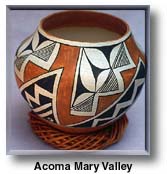 Pottery is clay that has been shaped and fired. Clay is dug from the ground, soaked and mixed with a grit. The most common technique is to roll the clay into coils, pinch them together and then smooth out the lines and gaps.
Pottery is clay that has been shaped and fired. Clay is dug from the ground, soaked and mixed with a grit. The most common technique is to roll the clay into coils, pinch them together and then smooth out the lines and gaps.
After the pottery has dried, it is painted and/or glazed. Before the piece is painted it is sometimes sanded with a smooth stone or sanding tool. The process of firing involves placing the pottery in an oven, on a grate or over a wood fire. Newer methods using electric kilns ensure consistency and involve fewer mishaps. Outside fires can grow too cold, too hot, or be sabotaged by the wind or rain.
Pottery fired in a traditional outside fire will bring a higher price. The fire clouds, or markings made by the direct fire contact, are proof that a piece has been fired by the traditional method.
When purchasing pottery, keep in mind that no two pieces are exactly alike. All handmade items have some imperfections, but this is what makes them original and unique. Look for cracks or chipped edges on pottery to avoid purchasing a product that is defective. Also check symmetry, details and styles of the pieces and select items that suit your own taste.
There are so many different styles and variations Native American arts and crafts that it is impossible to cover them all in depth. In future issues of Magazine, we will feature articles focused on specific Native American art forms.
If you would like more information on any of the arts and crafts covered in this article, please visit 's Trading Post, our online gift and book store. Many of the books used to research this article can be purchased from our online store.
Share this page on Facebook:
The Desert Environment
The North American Deserts
Desert Geological Terms



